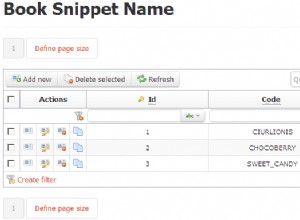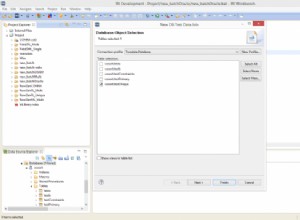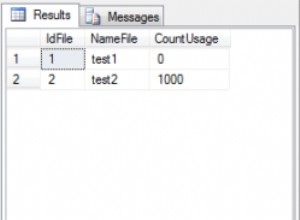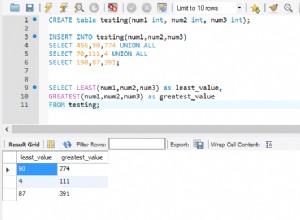Esto hace el trabajo para un single nivel de anidamiento:
Para enumerar solo las categorías raíz, los conteos incluyen subcategorías:
WITH root AS (
SELECT id AS cat_id, id AS sub_id
FROM category
WHERE is_base_template = false
AND "userId" = 1
)
SELECT c.cat_id, count(*)::int AS entries_in_cat
FROM (
TABLE root
UNION ALL
SELECT r.cat_id, c.id
FROM root r
JOIN category c ON c."parentCategoryId" = r.cat_id
) c
JOIN category_entries_entry e ON e."categoryId" = c.sub_id
GROUP BY c.cat_id;
El punto es unirse en sub_id , pero agrupar por cat_id .
Para enumerar categorías raíz como las anteriores y subcategorías además :
WITH root AS (
SELECT id AS cat_id, id AS sub_id
FROM category
WHERE is_base_template = false
AND "userId" = 1
)
, ct AS (
SELECT c.cat_id, c.sub_id, count(*)::int AS ct
FROM (
TABLE root
UNION ALL
SELECT r.cat_id, c.id AS sub_id
FROM root r
JOIN category c ON c."parentCategoryId" = r.cat_id
) c
JOIN category_entries_entry e ON e."categoryId" = c.sub_id
GROUP BY c.cat_id, c.sub_id
)
SELECT cat_id, sum(ct)::int AS entries_in_cat
FROM ct
GROUP BY 1
UNION ALL
SELECT sub_id, ct
FROM ct
WHERE cat_id <> sub_id;
db<>fiddle aquí
Para un número arbitrario de niveles de anidamiento, use un CTE recursivo. Ejemplo:
Acerca de la sintaxis abreviada opcional TABLE parent :




